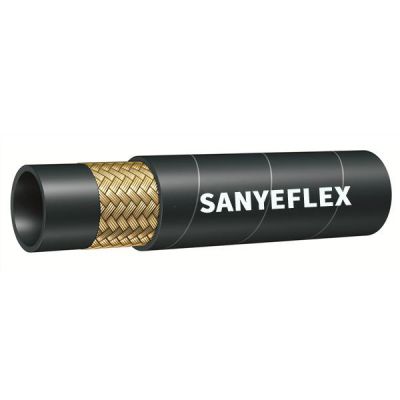Sep. 26, 2023
When it comes to industrial applications, having the right equipment is crucial for ensuring efficiency, safety, and productivity. One such vital component in many industries is the industrial hose. These versatile and robust hoses play a significant role in numerous sectors, from manufacturing to construction, agriculture to mining. In this comprehensive guide, we will delve into the world of industrial hoses, exploring their applications, types, materials, and essential factors to consider when choosing the most suitable hose for specific purposes.
An industrial hose is a flexible, hollow tube designed to transport a range of materials, such as liquids, gases, and solids, from one location to another within an industrial setting. These hoses are essential for various purposes, including conveying water, chemicals, oil, steam, and other substances vital to industrial processes. Their robust construction and flexibility make them indispensable components in a wide array of applications.
2.1. Manufacturing and Production Processes
In the manufacturing industry, industrial hoses play a pivotal role in transporting raw materials and finished products between different stages of production. From handling chemicals in chemical processing plants to conveying bulk materials in factories, hoses ensure a smooth and efficient production workflow.
2.2. Construction and Infrastructure Projects
Construction sites demand reliable hoses for tasks such as concrete pumping, dewatering, and material handling. Industrial hoses enable construction workers to transport various materials effectively, contributing to timely project completion and overall efficiency.
2.3. Agriculture and Farming
In the agricultural sector, hoses are vital for irrigation, water distribution, and spraying pesticides or fertilizers. These hoses assist farmers in maintaining proper crop health and achieving higher yields.
2.4. Mining and Extractive Industries
Mining operations often involve the transportation of abrasive materials and slurries over long distances. Industrial hoses designed to withstand harsh conditions ensure the smooth movement of materials, enhancing mining productivity.
2.5. Transportation and Automotive Industries
In the transportation and automotive sectors, industrial hoses are essential components in vehicles, responsible for cooling engines, supplying fuel, and ensuring proper brake function.
There is a wide variety of industrial hoses available, each specifically designed to handle particular materials and tasks. Some common types include:
3.1. PVC Hoses
Polyvinyl chloride (PVC) hoses are lightweight, flexible, and resistant to abrasion and chemicals. They are commonly used in water delivery, ventilation, and irrigation applications.
3.2. Rubber Hoses
Rubber hoses are known for their durability and ability to handle high-pressure applications. They are often used for conveying air, water, steam, and hydraulic fluids.
3.3. Composite Hoses
Composite hoses are constructed with multiple layers of materials, making them suitable for handling aggressive chemicals, petroleum products, and liquefied gases.
3.4. Stainless Steel Hoses
Stainless steel hoses are ideal for applications involving high temperatures, extreme pressures, and corrosive environments. They are commonly used in the chemical and food processing industries.
3.5. Thermoplastic Hoses
Thermoplastic hoses are lightweight and resistant to chemicals, making them suitable for handling hazardous materials, paint spraying, and compressed air.
Selecting the right industrial hose is crucial for ensuring safety, efficiency, and cost-effectiveness in any industrial operation. Here are some essential factors to consider:
4.1. Material Compatibility
Ensure that the hose material is compatible with the substance it will be conveying. Chemical resistance is vital to prevent hose degradation and material contamination.
4.2. Operating Pressure and Temperature
Choose a hose capable of handling the maximum pressure and temperature of the application. Operating beyond the hose's limits can lead to failure and safety hazards.
4.3. Flexibility and Bend Radius
Consider the hose's flexibility and bend radius, especially when tight bending is required in the application. Using a hose with inadequate flexibility can result in kinks and reduced flow rates.
4.4. Length and Size
Select the appropriate hose length and size for the task at hand, ensuring minimal waste and efficient material transport.
4.5. Environmental Factors
Consider external factors such as UV exposure, abrasion, and potential impact during usage. Opt for hoses designed to withstand environmental challenges.
Proper maintenance and handling of industrial hoses are essential for prolonging their lifespan and ensuring optimal performance. Some best practices include:
Regular inspection for signs of wear, damage, or leakage.
Proper storage away from direct sunlight and extreme temperatures.
Cleaning and flushing after each use to prevent material buildup.
Correctly storing coiled hoses to prevent kinking and tangling.
In conclusion, industrial hoses are invaluable components in a multitude of industries, facilitating the safe and efficient transport of materials. Understanding the diverse types of hoses and their applications is crucial for selecting the most suitable option for specific tasks. By considering factors such as material compatibility, operating conditions, and proper maintenance, industries can maximize the efficiency and productivity of their operations. We are an industrial hose supplier. If you are interested in our products, please contact us now!
Our Customer
Tel.: +86 400 0318 111
Email: admin@sanyeflex.com
Add.: #218 Zhongke Street, High-tech Zone, Hengshui City, Hebei Province, China



